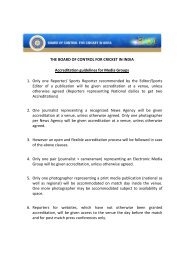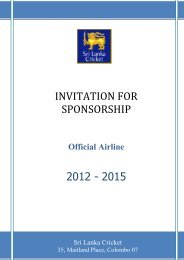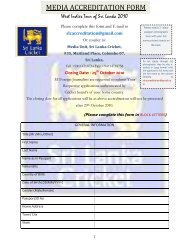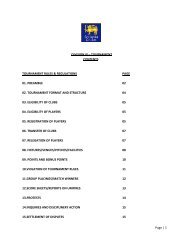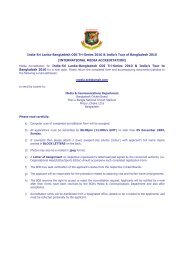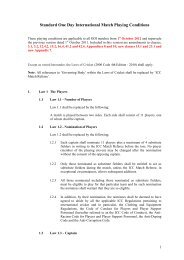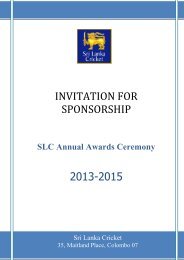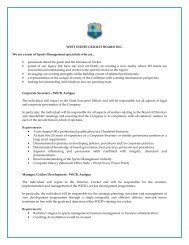Standard ODI Playing Conditions - Sri Lanka Cricket
Standard ODI Playing Conditions - Sri Lanka Cricket
Standard ODI Playing Conditions - Sri Lanka Cricket
You also want an ePaper? Increase the reach of your titles
YUMPU automatically turns print PDFs into web optimized ePapers that Google loves.
standard ONE-day INTERNatiONAL<br />
match playing conditions 04<br />
22 law 22 - The Over<br />
Law 22 shall apply subject to the following:<br />
22.1 Law 22.5 - Umpire miscounting<br />
T the following shall apply in addition to Law 22.5:<br />
Whenever possible the third umpire shall liaise with the scorers and if<br />
possible inform the on-field umpires if the over has been miscounted.<br />
23 law 23 - Dead Ball<br />
Law 23 shall apply subject to the addition of the following to Law 23.4.<br />
23.1 Law 23.4 – Umpire calling and signalling ‘Dead Ball’<br />
I<br />
in a match where Spydercam is being used, either umpire shall call and<br />
signal ‘dead ball’, should a ball that has been hit by the batsman make<br />
contact, while still in play, with the Spydercam or its cable. The ball shall<br />
not count as one of the over and no runs shall be scored.<br />
24 law 24 - No Ball<br />
Law 24 shall apply subject to the following:<br />
24.1 Law 24.1 (b) - Mode of delivery<br />
L<br />
T<br />
law 24.1 (b) shall be replaced by the following:<br />
the bowler may not deliver the ball underarm. If a bowler bowls a ball<br />
underarm the umpire shall call and signal no ball, and the ball is to be<br />
re-bowled overarm.<br />
24.2 Free Hit after a foot-fault no ball<br />
I<br />
T<br />
in addition to the above, the delivery following a no ball called for a foot<br />
fault (Law 24.5) shall be a free hit for whichever batsman is facing it. If<br />
the delivery for the free hit is not a legitimate delivery (any kind of no ball<br />
or a wide ball) then the next delivery will become a free hit for whichever<br />
batsman is facing it.<br />
For any free hit, the striker can be dismissed only under the circumstances<br />
that apply for a no ball, even if the delivery for the free hit is called wide ball.<br />
Field changes are not permitted for free hit deliveries unless there is a<br />
change of striker (the provisions of clause 41.2 shall apply).<br />
the umpires will signal a free hit by (after the normal No Ball signal)<br />
extending one arm straight upwards and moving it in a circular motion.<br />
24.3 Bowler breaking wicket in delivering ball<br />
D<br />
Either umpire shall call and signal No ball if, other than in an attempt to<br />
run out the non-striker under Clause 42.11, the bowler breaks the wicket<br />
at any time after the ball comes into play and before he completes the<br />
stride after the delivery stride.<br />
For the purpose of this clause, the amended definition of delivery stride<br />
from Appendix D - Laws of <strong>Cricket</strong> shall apply:<br />
delivery Stride is the stride during which the delivery swing is made,<br />
whether the ball is released or not. It starts when the bowler’s back foot<br />
lands for that stride and ends when the front foot lands in the same<br />
stride. The “stride after the delivery stride” is completed when the next<br />
foot lands i.e. when the back foot of the delivery stride lands again.<br />
4.19



